Central Coast
-
- Ready Your Salad Fork for Biden’s Offshore Energy Plans Marine News, Apr 2021 #22
In Antony and Cleopatra, Shakespeare coined the phrase “salad days” to mean a youthful time filled with unbridled enthusiasm and idealism. Indeed, youth, much like salad, is often raw, flavorful and most of all… green. Therefore, it is fitting to think of our present time as the salad days of offshore energy in the United States. Let’s dig in.
Executive Order appetizers
On January 27, President Biden took early steps to implement his campaign promise to transition the United States away from fossil fuels and invest in renewable energy, with the issuance of the “Executive Order on Tackling the Climate Crisis at Home and Abroad.” The Executive Order directs the Secretary of the Interior to (1) pause on entering into new oil and natural gas leases on public lands or offshore waters, (2) launch a rigorous review of all existing leasing and permitting practices related to fossil fuel development on public lands and waters and (3) identify steps that can be taken to double renewable energy production from offshore wind by 2030.The Executive Order’s impact on offshore oil and gas development has been immediate, with the Bureau of Ocean Energy Management (BOEM) effectively canceling the first two planned offshore oil lease sales of 2021. On February 12, BOEM announced that it was rescinding the Record of Decision for Gulf of Mexico Oil and Gas Lease Sale 257, scheduled to occur on March 17, 2021. The sale would have included approximately 14,594 unleased blocks, totaling 78.2 million acres of the Gulf of Mexico.
BOEM’s Outer Continental Shelf (OCS) Oil and Gas Program for 2017-2022 also included a lease sale in the Cook Inlet Planning Area, which was scheduled for 2021. On January 15, BOEM released a draft Environmental Impact Statement (EIS) for public comment, analyzing the potential environmental impacts of holding the proposed sale. On February 4, BOEM canceled the draft EIS public comment period, effectively ending the planned sale. It is reasonable to assume that the two other anticipated lease sales under BOEM’s OCS Oil and Gas Program, scheduled to occur in late 2021 and 2022 to lease additional blocks in the Gulf of Mexico, will not go forward.
Accordingly, the Biden Administration has sent an unequivocal message—the immediate future of U.S. offshore energy lies in renewables.
Jones Act main course
While President Biden’s Climate Change Executive Order closed the door on oil and gas lease opportunities, it opened a window on offshore wind. In fact, based on projected development opportunities, the Executive Order’s policy goal to double renewable energy production from offshore wind by 2030 seems to undersell the sector’s prospects. The work towards achieving—and exceeding these offshore wind policy goals is well underway, with BOEM announcing on February 3 that the agency has resumed its environmental review of the Vineyard Wind Project. The project aims to construct 62 wind turbine generators 15 miles off the coast of Massachusetts, which will generate up to 800 megawatts of electricity (enough electricity to power 400,000 homes).Jones Act vessel operators will play a major role in developing Vineyard Wind and numerous other offshore wind projects undergoing federal review. President Biden reaffirmed this fact in his January 25th “Executive Order on Ensuring the Future Is Made in All of America by All of America’s Workers,” which included the Jones Act in its list of “Made in America Laws.” The associated White House press release noted that “the President will continue to be a strong advocate for the Jones Act... which supports American production and America’s workers,” and further that “with the signing of the 2021 National Defense Authorization Act, the Jones Act has also been affirmed as an opportunity to invest in America’s workers as we build offshore renewable energy, in line with the President’s goals to build our clean energy future here in America.” As discussed in the February edition of Marine News (“Winds of Change in D.C.”), the 2021 National Defense Authorization Act, enacted by a Congressional veto override on January 1, 2021, amended the Outer Continental Shelf Lands Act to clarify that the Jones Act extends to installations on the OCS engaged in the exploration, development, and production of non-mineral energy resources, including wind.
Desserts ahead
These salad days of offshore renewable energy development may be just an appetizer. While Vineyard Wind leads the way, BOEM has received Construction and Operation Plans (COPs) for 10 U.S. offshore wind projects. Submission of the COPs represents a critical step in the administrative process used to approve renewable energy projects. The COPs, once deemed complete by BOEM, undergo an environmental review under the National Environmental Policy Act (NEPA), which requires significant interagency consultation and public engagement. In addition, once the NEPA process is complete and the COPs approved, the developer must submit a Facility Design Report, a Fabrication and Installation Report, and sufficient financial assurances to support planned decommissioning costs. In many ways, BOEM is, the most critical federal agency when it comes to the future of U.S. offshore maritime operations. The speed with which the agency completes its administrative review will dictate the market entry timing for stakeholders looking to engage in the construction and operation of these offshore wind projects.Importantly, the menu of potential offshore energy projects is not limited to wind. On February 16, BOEM issued a lease to Oregon State University for the PacWave South Project, the first wave energy research project in Federal waters. The testing area, which will span approximately 1,696 acres or 2.65 square miles, is located approximately seven miles off Oregon’s central coast. Once fully licensed by the Federal Energy Regulatory Commission (FERC), construction will commence with operations scheduled to begin as early as 2023. The project will consist of four test berths to support the testing of up to 20 wave energy converter devices, with an anticipated capacity of 20 megawatts. If the project proves successful, the U.S. could someday find its energy demands met by the wind and the waves. For now, however, let’s just take our offshore energy development one course at a time.
-
- Offshore Wind: California's New Gold Rush Maritime Reporter, May 2019 #16
were within the NREL study referenced above): the Humboldt Call Area off the north coast and the Morro Bay and Diablo Canyon Call Areas, both off the central coast. These areas cover approximately 1,073 square statute miles (687,823 acres). Comments – and nominations – were due January 28, 2019.Indeed, there
-
 )
March 2024 - Marine Technology Reporter page: 33
)
March 2024 - Marine Technology Reporter page: 33regulated industry in the world.” How- ever, commercial success depends on many factors, not least a predictable OPEX. Over the past four years, SMD has worked with Oil States Industries to calculate cost per tonne ? gures for prospective customers. Patania II uses jet water pumps to Oil States’
-
 )
March 2024 - Marine Technology Reporter page: 19
)
March 2024 - Marine Technology Reporter page: 19for cloud-based online reporting and visualization, FORCE Tech- pipelines/Potential distribution plot for 3D structures to iden- nology can provide a central portal for information on all CP tify hotspots/areas of under-protection, Anode current output at an entire development or even multiple developments
-
 )
March 2024 - Marine Technology Reporter page: 9
)
March 2024 - Marine Technology Reporter page: 9from marinas along the western coast. The exact number of lizing laser detection systems can detect mines just below the mines, as well as their locations, remains largely a mystery, surface, even those hiding in murky water. The Airborne Laser although reports suggest that over three hundred have been
-
 )
April 2024 - Maritime Reporter and Engineering News page: 38
)
April 2024 - Maritime Reporter and Engineering News page: 38for scheduled delivery from South Korea’s Hyundai Mipo Dockyard in 2025. EPS will charter the ships out to Crowley, who will deploy them on its U.S.-Central America trade connecting U.S. markets to Nicaragua, Hon- duras, Guatemala and El Salvador. Each ship will feature 300 Image courtesy HRDD refrigerated
-
 )
April 2024 - Maritime Reporter and Engineering News page: 27
)
April 2024 - Maritime Reporter and Engineering News page: 27RADM PHILIP SOBECK, MILITARY SEALIFT COMMAND With COVID, we had to make some hard choices for our Do your CIVMARs have upward mobility? mariners because we couldn’t rotate. Many of our mariners The Navy has Sailors who become “Mustangs,” and work found other employment, and were able to use their skills
-
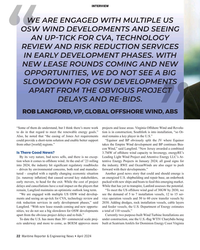 )
April 2024 - Maritime Reporter and Engineering News page: 22
)
April 2024 - Maritime Reporter and Engineering News page: 22INTERVIEW WE ARE ENGAGED WITH MULTIPLE US OSW WIND DEVELOPMENTS AND SEEING AN UP-TICK FOR CVA, TECHNOLOGY REVIEW AND RISK REDUCTION SERVICES IN EARLY DEVELOPMENT PHASES. WITH NEW LEASE ROUNDS COMING AND NEW OPPORTUNITIES, WE DO NOT SEE A BIG SLOWDOWN FOR OSW DEVELOPMENTS APART FROM THE OBVIOUS
-
 )
April 2024 - Maritime Reporter and Engineering News page: 18
)
April 2024 - Maritime Reporter and Engineering News page: 18MARKETS & gas activity returns, we anticipate that supply of the vessels The Question of Emissions to offshore wind projects will reduce, driving demand for ad- Given that SOVs and CSOVs operate in a segment target- ditional CSOVs. ing reduced emissions, and many operate in the North Eu- Outside of China
-
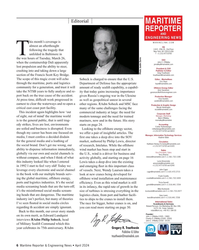 )
April 2024 - Maritime Reporter and Engineering News page: 6
)
April 2024 - Maritime Reporter and Engineering News page: 6Editorial MARITIME REPORTER AND ENGINEERING NEWS his month’s coverage is M A R I N E L I N K . C O M almost an afterthought HQ 118 E. 25th St., 2nd Floor following the tragedy that New York, NY 10010 USA T +1.212.477.6700 Tunfolded in Baltimore in the wee hours of Tuesday, March 26, CEO John C.
-
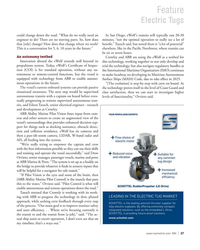 )
April 2024 - Marine News page: 37
)
April 2024 - Marine News page: 37Feature Electric Tugs could change down the road. “What do we really need an In San Diego, eWolf’s transits will typically run 20-30 engineer to do? There are no moving parts. So, how does minutes, “not the optimal operation to really see a lot of that [role] change? How does that change where we work?
-
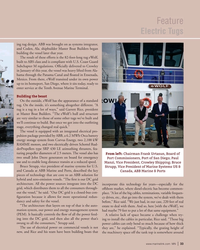 )
April 2024 - Marine News page: 33
)
April 2024 - Marine News page: 33Feature Electric Tugs ing tug design. ABB was brought on as systems integrator, and Coden, Ala. shipbuilder Master Boat Builders began building the vessel later that year. The result of these efforts is the 82-foot-long tug eWolf, built to ABS class and is compliant with U.S. Coast Guard Subchapter M
-
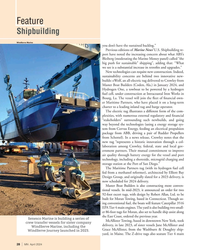 )
April 2024 - Marine News page: 28
)
April 2024 - Marine News page: 28Feature Shipbuilding WindServe Marine you don’t have the sustained backlog.” Previous editions of Marine News’ U.S. Shipbuilding re- port have noted the increasing concern about what ABS’s Bleiberg (moderating the Marine Money panel) called “the big push for sustainable” shipping”, adding that: “What we
-
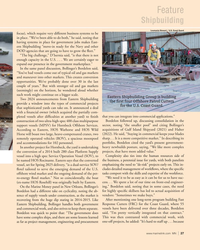 )
April 2024 - Marine News page: 27
)
April 2024 - Marine News page: 27Feature Shipbuilding Loumania Stewart / U.S. Coast Guard focus), which require very different business systems to be in place. “We’ve been able to do both,” he said, noting that having systems in place for government jobs makes East- ern Shipbuilding “move-in ready for the Navy and other DOD agencies
-
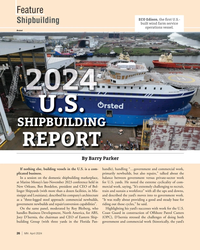 )
April 2024 - Marine News page: 26
)
April 2024 - Marine News page: 26Feature ECO Edison, the ? rst U.S.- Shipbuilding built wind farm service operations vessel. Ørsted U.S. SHIPBUILDING REPORT By Barry Parker If nothing else, building vessels in the U.S. is a com- handle), handling “…government and commercial work, plicated business. primarily newbuilds, but also
-
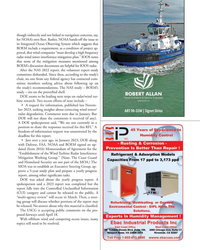 )
April 2024 - Marine News page: 25
)
April 2024 - Marine News page: 25though indirectly and not linked to navigation concerns, say, for NOAA’s own ? eet. Rather, NOAA hands-off the issue to its Integrated Ocean Observing System which suggests that BOEM include a requirement, as a condition of project ap- proval, that wind companies “must develop a high frequency radar
-
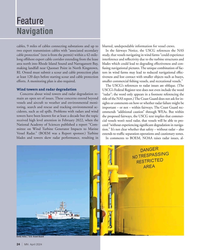 )
April 2024 - Marine News page: 24
)
April 2024 - Marine News page: 24Feature Navigation cables, 9 miles of cables connecting substations and up to blurred, undependable information for vessel crews. two export transmission cables with “associated secondary In the fairways Notice, the USCG references the NAS cable protection” (text is from the permit) within a 42-mile-
-
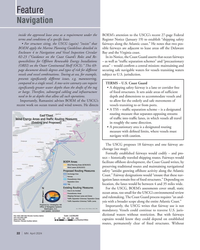 )
April 2024 - Marine News page: 22
)
April 2024 - Marine News page: 22– as well as “traf? c separation schemes” and “precautionary (OREI) on the Outer Continental Shelf (OCS).” This 69- areas” – would con? rm a central mission: maintaining and page document details degrees and types of risk for different securing safe navigable waters for vessels transiting waters
-
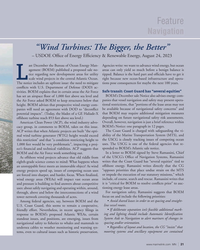 )
April 2024 - Marine News page: 21
)
April 2024 - Marine News page: 21balance is tice regarding new development areas for utility tipped. Balance is the hard part and of? cials have to get it L scale wind projects in the central Atlantic Ocean. right because new ocean-based infrastructure and opera- The notice includes an upfront issue: the need to mitigate tions pose consequence
-
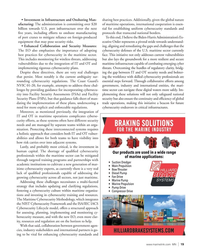 )
April 2024 - Marine News page: 19
)
April 2024 - Marine News page: 19• Investment in Infrastructure and Onshoring Man- sharing best practices. Additionally, given the global nature ufacturing: The administration is committing over $20 of maritime operations, international cooperation is essen- billion towards U.S. port infrastructure over the next tial for establishing
-
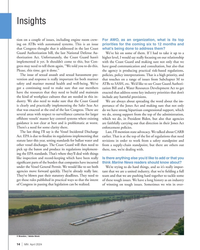 )
April 2024 - Marine News page: 14
)
April 2024 - Marine News page: 14Insights tion on a couple of issues, including engine room crew- For AWO, as an organization, what is its top ing on ATBs with automated systems. This is an issue priorities for the coming six to 12 months and that Congress thought that it addressed in the last Coast what’s being done to address them? Gua
-
 )
April 2024 - Marine News page: 13
)
April 2024 - Marine News page: 13Q&A We’ve still got some work to do. Despite the new guid- Looking across the industry, what are some ance, we are seeing differences in the way that the Coast other important regulatory issues that AWO is Guard is applying crewing and life-saving requirements to currently paying attention to? ATBs from
-
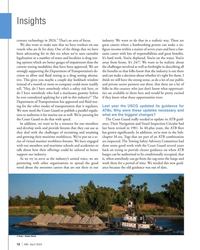 )
April 2024 - Marine News page: 12
)
April 2024 - Marine News page: 12Insights century technology in 2024.” That’s an area of focus. industry. We want to do that in a realistic way. These are We also want to make sure that we have workers on our great careers where a hardworking person can make a six- vessels who are ? t for duty. One of the things that we have ? gure
-
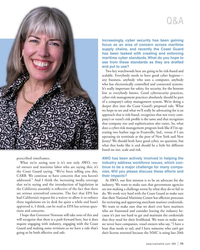 )
April 2024 - Marine News page: 11
)
April 2024 - Marine News page: 11Q&A Increasingly, cyber security has been gaining focus as an area of concern across maritime supply chains, and recently the Coast Guard has been tasked with creating and enforcing maritime cyber standards. What do you hope to see from these standards as they are drafted and put to use? Two key
-
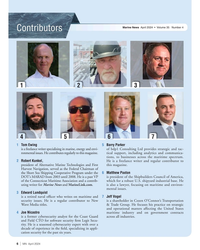 )
April 2024 - Marine News page: 6
)
April 2024 - Marine News page: 6Marine News April 2024 • Volume 35 Number 4 Contributors 1 2 3 5 4 6 7 1 Tom Ewing 5 Barry Parker is a freelance writer specializing in marine, energy and envi- of bdp1 Consulting Ltd provides strategic and tac- ronmental issues. He contributes regularly to this magazine. tical support, including
-
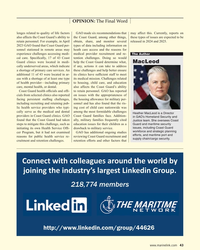 )
February 2024 - Maritime Reporter and Engineering News page: 43
)
February 2024 - Maritime Reporter and Engineering News page: 43OPINION: The Final Word lenges related to quality of life factors GAO made six recommendations that may affect this. Currently, reports on also affects the Coast Guard’s ability to the Coast Guard, among other things, these types of issues are expected to be retain personnel. For example, in April
